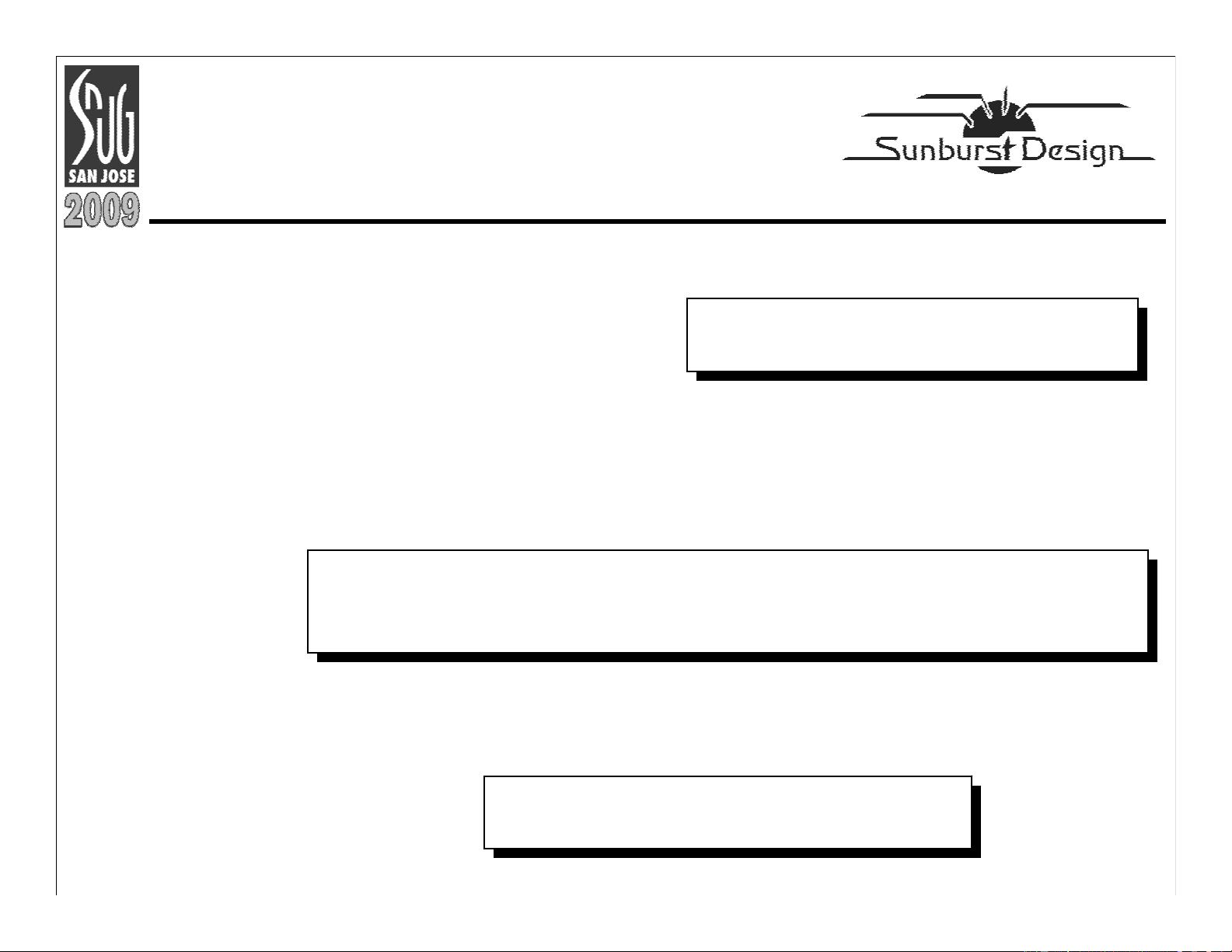SystemVerilog Assertions - Design Tricks and SVA Bind Files_pres
### SystemVerilog Assertions - Key Concepts and Design Tricks #### 1. Introduction to SystemVerilog Assertions SystemVerilog Assertions (SVA) are a powerful feature in SystemVerilog that enable designers and verification engineers to specify the expected behavior of digital systems. These assertions serve as a means to document the intended behavior of a design and help identify both design and verification flaws related to the system under development and testing. #### 2. Assertions: Definition and Importance ##### 2.1 What is an Assertion? An assertion is fundamentally a statement of fact or claim of truth made about a design. Engineers use assertions to declare that specific conditions are always or never true about a design. If these claims prove false, the assertion fails, indicating a discrepancy between the expected and actual behavior of the system. Assertions are essential because they: - Act as active design comments that document the intended behavior. - Help in identifying design and verification issues early in the development cycle. - Can be used in both simulation and formal verification. ##### 2.2 Types of Assertions SystemVerilog supports two primary types of assertions: 1. **Immediate Assertions**: These assertions execute once and are placed inline with the code. They are not very useful except in specific scenarios where immediate feedback is required during simulation. 2. **Concurrent Assertions**: These assertions run continuously during simulation and are used to monitor the design over time. They are crucial for detecting violations of design properties and are often used in formal verification. #### 3. Properties: Defining Design Rules ##### 3.1 What is a Property? A property is a rule that is asserted (enabled) to passively test a design. It can be a simple Boolean test regarding conditions that should always hold true about the design, or it can be a sampled sequence of signals that should follow a legal and prescribed protocol. For formal analysis, a property describes the environment of the block under verification, i.e., what is legal behavior of the inputs. Properties are critical because they: - Enable precise specification of design expectations. - Allow for the creation of complex behavioral models. - Can be used to define temporal relationships between signals. #### 4. Concurrent Assertions: Enabling Continuous Monitoring Concurrent assertions are assertions that run continuously during simulation. They are essential for detecting violations of design properties and are often used in formal verification. They allow engineers to monitor the design over time and ensure that it behaves as expected. Concurrent assertions are specified using the `assert` keyword and are typically defined outside of any procedural blocks, making them active throughout the simulation. This makes them ideal for: - Continuous monitoring of the design. - Detecting errors early in the simulation process. - Enhancing the coverage of the verification process. #### 5. Immediate Assertions: Specific Use Cases Immediate assertions, on the other hand, execute only once and are placed inline with the code. They are less commonly used but can be helpful in certain scenarios, such as: - Debugging: To check the initial state of the design. - Sanity checks: To verify that the initial configuration is correct. - Early detection: To detect issues early in the simulation process. #### 6. Design Tricks: Enhancing Usability The following are some design tricks that can enhance the usability and effectiveness of SystemVerilog Assertions: ##### 6.1 Long Label Usage Using long labels for assertions helps in providing clear error messages. This makes it easier to understand where the failure occurred and why. For example, consider the following assertion: ```verilog assert property (@(posedge clk) disable iff (!rst_n) (q == $past(d))) else $display("ERROR: q did not follow d"); ``` Here, the label "ERROR: q did not follow d" provides a clear indication of the issue. Long labels are particularly useful when debugging complex designs. ##### 6.2 Concise Assertion Coding Styles Using concise coding styles for assertions can improve readability and maintainability. For example, using shorthand operators and removing unnecessary parentheses can make assertions more readable. Additionally, consistent formatting and indentation can help in quickly identifying the structure of the assertion. ##### 6.3 SVABind Files SVA bind files are a mechanism for associating SVA properties with RTL code. This association enables the properties to be checked during simulation and formal verification without modifying the RTL code. Using bind files can help in: - Keeping the RTL code clean and free from assertions. - Reusing properties across multiple designs. - Managing and updating properties independently of the RTL code. #### 7. Summary & Conclusions In conclusion, SystemVerilog Assertions are a valuable tool for specifying and verifying the behavior of digital systems. By understanding the fundamental concepts of assertions and properties, as well as employing best practices such as using long labels and concise coding styles, engineers can significantly improve the quality and reliability of their designs. Furthermore, leveraging concurrent assertions and SVA bind files can streamline the verification process and enhance the overall efficiency of the design flow.





剩余42页未读,继续阅读

 wenthent2013-03-06没想到竟然是PPT类似的书。看着满清楚,但是文字就简单了些。最好结合其他的SPEC看
wenthent2013-03-06没想到竟然是PPT类似的书。看着满清楚,但是文字就简单了些。最好结合其他的SPEC看 mmzyw2013-03-04例子标注的还挺清晰的,比较基础~~
mmzyw2013-03-04例子标注的还挺清晰的,比较基础~~ longyangyu0072018-05-12例子标注清晰,还不错~
longyangyu0072018-05-12例子标注清晰,还不错~ KSCNN2019-09-10很有帮助,值得学习
KSCNN2019-09-10很有帮助,值得学习
- 粉丝: 0
- 资源: 28
 我的内容管理
展开
我的内容管理
展开
 我的资源
快来上传第一个资源
我的资源
快来上传第一个资源
 我的收益 登录查看自己的收益
我的收益 登录查看自己的收益 我的积分
登录查看自己的积分
我的积分
登录查看自己的积分
 我的C币
登录后查看C币余额
我的C币
登录后查看C币余额
 我的收藏
我的收藏  我的下载
我的下载  下载帮助
下载帮助

 前往需求广场,查看用户热搜
前往需求广场,查看用户热搜最新资源
- PFC开关电源仿真与全桥LLC串联谐振电源Simulink模型详解,PFC开关电源仿真与全桥LLC串联谐振模型:Simulink建模及参数计算说明,PFC开关电源仿真 全桥LLC 单相Boost PF
- IEEE 39节点系统中的双馈风机风电场:带有虚拟惯量与综合控制的一次调频技术分析与应用模拟,IEEE 39节点风电一次调频系统:含双馈风机与虚拟惯量、下垂控制及综合惯量控制的时空分布研究,IEEE3
- 双馈永磁同步风电机组并网仿真模型及其短路故障分析:一个可调容量的9MW风电场模拟研究报告,“kw级别双馈永磁风电机组与PMSG并网仿真模型:风电场短路故障分析与多风速模拟研究”,双馈永磁风电机组并网仿
- 小数分频锁相环与环形振荡器结构在smic 28nm工艺下的设计原理及版图详解,小数分频锁相环与环形振荡器结构设计:SMIC 28nm技术下的版图设计与原理解析,小数分频锁相环,环形振荡器结构,smic
- 基于python的区块链简单实现
- 基于VSG控制的MMC变流器模块化研究:电网频率电压模拟下的功率输出与调节策略,基于VSG控制的MMC变流器模块化研究:电网频率电压模拟下的功率输出与调节策略,基于VSG控制(同步发电机控制)的模块化
- 永磁同步电机旋转高频信号注入法:零低速无位置控制的优化仿真研究及其低噪声低损耗优势分析,永磁同步电机旋转高频信号注入法:零低速无位置控制的优化仿真研究及与高频方波信号注入法的对比分析,永磁同步电机旋转
- Simulink光伏并网与同步发电机优化:频率惯量支撑与波形效果卓越,光强、温度及减载率可灵活调整,Simulink光伏并同步发电机频率惯量支撑技术研究:光强、温度与减载率可调的优化波形效果探索,si
- 基于java的区块链简单实现
- **Qt CPP多列时间轴控件:故事大纲展示与自由编辑的强大工具**,QtCPP时间轴控件:多功能时间管理,事件故事线编排的完美工具,Qt CPP实现的多列时间轴控件、可与多段字符串格式自由转、也可手
- 基于DSP28377的三相并网双二阶锁相环(DSOGI-PLL)程序设计方法探讨,基于DSP28377的三相并网双二阶锁相环DSOGI-PLL程序设计解析与实现,基于DSP28377的三相并网双二阶锁
- MATLAB中基于DWA算法的机器人局部避障路径规划过程解析:速度控制优化与仿真实验结果,MATLAB动态窗口算法DWA实现机器人局部避障路径规划的优化与仿真研究:速度控制下的最优路线决策,MATLA
- 电气安装工 中级工.pdf
- 基于dq旋转坐标系的构网变流器功率控制策略:下垂控制实现功率准确跟踪与电压前馈双闭环控制,基于dq坐标系的构网变流器功率控制策略:下垂控制结合PI控制实现精准功率跟踪与电压稳定,构网变流器功率控制控制
- 电气安装工 高级工.pdf
- KR_70_R2100_E_ES 20240417(1).stp


 信息提交成功
信息提交成功